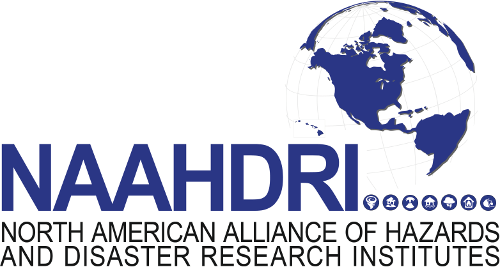NAAHDRI Research Incubator Events
In a changing climate, natural hazards worsened by human activities have affected more people. In response, it is imperative to conduct interdisciplinary research to address the emerging societal and infrastructure problems that emerge in disasters. The NAAHDRI Research Committee launched a series of Research Incubator Events to stimulate collaboration across disciplines and help researchers within NAAHDRI develop their career trajectories, find partnerships, and stimulate conversations (especially among junior faculty members, postdocs, and senior Ph.D. students). These activities were held quarterly through Zoom meetings. In each event, five researchers from science, engineering, social science, and economics presented their research for 5 minutes and then participants joined breakout rooms with each speaker for 30 minutes to discuss potential collaboration, to debate, and to engage in conversation! Open to all, these events helped spark new collaborations and new research ideas.
Members of NAAHDRI Research Committee
Co-Chairs: John van de Lindt, Structural/CR & Jamie Kruse, Econ/CR
- Grace Yan – MST, Structural/Wind
- Erouscilla (Pat) Joseph – U West Indies, Chemistry/Seismic
- Ioannis Zisis– FIU, Wind
- Robert Weiss – VT, Nat hazards/Geo
- Xinyue Ye – TAMU, Planning
Event Information
If you would like to present in any of the four events, please send an email to Dr. John van de Lindt at jwv@colostate.edu and Dr. Grace Yan at yang@mst.edu and indicate which day you would like to participate.
Note that this is a rapid 5-minute presentation, so plan accordingly. We suggest using four slides to present your ideas and one slide to explain your biggest barriers or roadblocks. However, you are welcome to use more slides to simply introduce your existing research, the capacity of your research lab or group, and invite collaborators for proposal ideas. Download Event Flyer Here
Past Speakers
Friday, February 10, 2023, 1:00 to 2:00 p.m. CT
1. Seeing Like A Citizen: Examining Resident Perception on Role of Government in Disaster Risk Reduction in The Bahamas
Barrise Griffin, masofdisasters@gmail.com
Abstract: Perception of risk is socially constructed. Previously overlooked, recent studies now highlight the important link between perceptions of risk, trust in government, and people’s decision-making behaviour in disaster preparation; these perceptions influence whether households will adopt adequate preparedness strategies and adhere to government warnings. With no considerable studies on social perceptions of risk and trust in government in the Caribbean—a region extremely vulnerable to the consequences of natural hazards, this talk aims to provide insight on how household preparedness in The Bahamas is influenced by perceptions of risk and trust in government. Griffin will share her research findings.
 Barrise Griffin is The Master of Disasters. As an expert in disaster risk management and development, Barrise’s work focuses on critically examining the social perceptions of risk to create more effective strategies in disaster preparedness and response throughout the Caribbean. She received her Master’s, awarded with Distinction, in Disasters, Adaptation & Development in 2020 from King’s College London, with particular focus on Human Mobility, Water Resources & Policy, and International Development. More than being an expert, Barrise sees it as her calling to craft policies and execute plans that improve crisis response and disaster management in the Caribbean, and for Small Island Developing States at large. Her long-term goal is to become a national-level policy adviser. Her recent work focused on the human impacts of the 2019 Hurricane Dorian in the “I Survived Dorian” project with the Climate Change Adaptation and Resilience Research Centre with The University of The Bahamas.
Barrise Griffin is The Master of Disasters. As an expert in disaster risk management and development, Barrise’s work focuses on critically examining the social perceptions of risk to create more effective strategies in disaster preparedness and response throughout the Caribbean. She received her Master’s, awarded with Distinction, in Disasters, Adaptation & Development in 2020 from King’s College London, with particular focus on Human Mobility, Water Resources & Policy, and International Development. More than being an expert, Barrise sees it as her calling to craft policies and execute plans that improve crisis response and disaster management in the Caribbean, and for Small Island Developing States at large. Her long-term goal is to become a national-level policy adviser. Her recent work focused on the human impacts of the 2019 Hurricane Dorian in the “I Survived Dorian” project with the Climate Change Adaptation and Resilience Research Centre with The University of The Bahamas.
2. The Socio-Physical Aspects of Natural Hazards in Modeling Impact and Recovery
Stephanie Pilkington, spilking@uncc.edu
Abstract: The rising interest in community resilience from natural hazards has highlighted a gap in understanding of how societal factors influence overall physical damage from extreme events. Within an engineering research space, focus has previously been on physics-focused assessment and modeling of how structures fail under, for example, extreme wind loads. However, modeling community resilience requires a connection between people (individuals and communities) and their infrastructure (including buildings) as well as the hazard itself. Overcoming this hurdle requires (1) further collaboration with social scientists and (2) adjusting our data collection goals. Engineers are primarily educated on matters of physics and how buildings “should” behave under idealized conditions. However, the occupants of a building could influence the resistive capacity of the building to extreme loads. For example, the decision making process for installing hurricane ties in one’s home will impact its resulting damage state following a hurricane. Secondly, data gathering needs to highlight this overlap and implement a degree of uniformity across organizations and jurisdictional lines. Overall, to successfully model community resilience, holistically, more consideration, collaboration, and incorporation, across engineering, social science, and atmospheric science is needed.
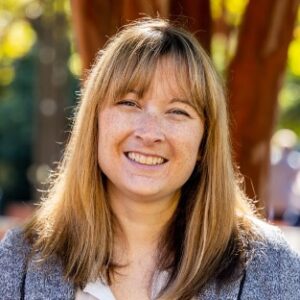 Stephanie Pilkington is an Assistant Professor in the College of Engineering at the University of North Carolina at Charlotte. She received her Masters and Ph.D. in Civil Engineering from Colorado State University while contributing to the NIST Community Resilience Center of Excellence. Her bachelors degree, also in civil engineering, is from Virginia Tech. Currently her research focuses on how social aspects interact with physical, structural, characteristics to influence resulting damage from extreme events. She also conducts research related to robotics and artificial intelligence applications for infrastructure, construction, and post-disaster data gathering. Dr. Pilkington was a former US Air Force, civilian, environmental engineer and has previously storm chased in her spare time. This has resulted in an academic interest in “breadth of knowledge” across all aspects of natural hazards.
Stephanie Pilkington is an Assistant Professor in the College of Engineering at the University of North Carolina at Charlotte. She received her Masters and Ph.D. in Civil Engineering from Colorado State University while contributing to the NIST Community Resilience Center of Excellence. Her bachelors degree, also in civil engineering, is from Virginia Tech. Currently her research focuses on how social aspects interact with physical, structural, characteristics to influence resulting damage from extreme events. She also conducts research related to robotics and artificial intelligence applications for infrastructure, construction, and post-disaster data gathering. Dr. Pilkington was a former US Air Force, civilian, environmental engineer and has previously storm chased in her spare time. This has resulted in an academic interest in “breadth of knowledge” across all aspects of natural hazards.
3. Geotechnical Earthquake Engineering Through the Lens of Data Science
Katerina Ziotopoulou, kziotopoulou@ucdavis.edu
Abstract: Earthquake-induced soil liquefaction is a leading cause of earthquake damage worldwide. In Christchurch alone impacts cost more than 10 billion dollars. Research has made strides in advancing the science and engineering behind liquefaction evaluations, but unexpected impacts indicate gaps in our knowledge. Such incidents are justified: geosystems are complex and hard to sample, and earthquakes are rare, stochastic events. The problem relates to our approaches: empirical models do not have a sound theoretical basis; simplified models are based on observed data, honoring some theory but can misbehave in out-of-sample cases; and advanced numerical models, although more rigorous, can be challenging to interpret while their validation is data- and problem-specific. As geotechnical engineers, we will always be making inferences that can be significantly strengthened if we reshape our approach to learning and extracting value from our data. The increasing availability of geotechnical data across length and material scales creates an opportune moment to exploit the convergence of Data Science into geotechnical engineering. However, Data Science is liquefaction-illiterate and research is needed to integrate it with our knowledge. This presentation will touch on promising fronts towards this integration and outline recent progress as well as future potentials.
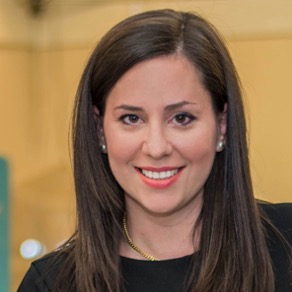 Katerina Ziotopoulou is an Associate Professor in Civil and Environmental Engineering at the University of California at Davis since August of 2016. She received her PhD and MS degrees in Civil Engineering from UC Davis, and her undergraduate 5-year diploma degree in Civil Engineering from the National Technical University of Athens, Greece. Currently, her research focuses on numerically and experimentally studying ground failure due to earthquake-induced liquefaction and its mitigation, developing numerical tools that advance predictive capabilities, and exploring data-driven approaches for geotechnical earthquake engineering applications. She is the recipient of the 2021 Arthur Casagrande Professional Development Award of ASCE, the National Science Foundation CAREER Award, and the 2017 Greek International Woman in Science Award.
Katerina Ziotopoulou is an Associate Professor in Civil and Environmental Engineering at the University of California at Davis since August of 2016. She received her PhD and MS degrees in Civil Engineering from UC Davis, and her undergraduate 5-year diploma degree in Civil Engineering from the National Technical University of Athens, Greece. Currently, her research focuses on numerically and experimentally studying ground failure due to earthquake-induced liquefaction and its mitigation, developing numerical tools that advance predictive capabilities, and exploring data-driven approaches for geotechnical earthquake engineering applications. She is the recipient of the 2021 Arthur Casagrande Professional Development Award of ASCE, the National Science Foundation CAREER Award, and the 2017 Greek International Woman in Science Award.
4. Prediction of Wind and Rain Vulnerabilities of Mid/high-rise Residential Buildings during Hurricane Events with Component-based Probabilistic Vulnerability Model
Zhuoxuan Wei, weiz2018@my.fit.edu; cornmarswei@gmail.com
Abstract: Typically, mid/high-rise commercial residential buildings (MHR) are engineered buildings with more than 3 stories which suffer minor structural damage during hurricane events. However recent hurricanes in Florida and elsewhere have shown the vulnerability of MHR to rainwater intrusion through defects and breaches of the fenestration of the buildings. This presentation introduces a new component-based probabilistic vulnerability model to produce realistic estimates of interior and contents damage in MHR. The physics of rainwater ingress, distribution and propagation provide the basis for the model, which combines estimates of impinging and surface run-off wind driven rain, envelope defects and breaches, interior water distribution and propagation, and component cost analyses. The model incorporates an approach of dealing with hazard variables to decouple rain hazard model from vulnerability model and produce wind and rain combined vulnerability. The resulting vulnerability curves and surfaces lead to improved loss projections and facilitate the evaluation of the effectiveness of mitigation measures.
 Zhuoxuan Wei is a Ph.D. candidate majoring in civil engineering from Florida Institute of Technology (FIT). He got his bachelor’s degree in construction management at Sichuan University, and master’s degree in civil engineering at FIT. He is a graduate research assistant and participates in the projects of Florida Public Hurricane Loss Model (FPHLM) and Wind Hazard and Infrastructure Performance Center (WHIP-C). Currently, his research focuses on loss assessment and recovery of mid/high-rise commercial residential buildings due to hurricane damage.
Zhuoxuan Wei is a Ph.D. candidate majoring in civil engineering from Florida Institute of Technology (FIT). He got his bachelor’s degree in construction management at Sichuan University, and master’s degree in civil engineering at FIT. He is a graduate research assistant and participates in the projects of Florida Public Hurricane Loss Model (FPHLM) and Wind Hazard and Infrastructure Performance Center (WHIP-C). Currently, his research focuses on loss assessment and recovery of mid/high-rise commercial residential buildings due to hurricane damage.
5. Next Generation Digital Twin Systems for Disaster Analytics and Communication
Ibrahim Demir, ibrahim-demir@uiowa.edu
Abstract: Recent developments in web technologies make it easy to manage, analyze, visualize, and share large data sets in earth sciences with the researchers and public. Web technologies, intelligent systems, artificial intelligence, and virtual and augmented reality techniques provide advanced capabilities for visual data analytics, knowledge discovery, and smart communication platforms. This presentation provides an overview of developments in state-of-the-art web systems for hydrological analysis and communication, presents real-world applications of these techniques in water resources and disaster mitigation, and outlines next-generation web standards and technologies to support research and education. The showcased projects include real-time applications on client-side systems for large-scale physical modeling, data analytics, what-if scenario evaluation, continuous data streaming protocols, volunteer/edge computing, and intelligent sensor systems.
 Ibrahim Demir is an Associate Professor at the Civil and Environmental Engineering and Electrical and Computer Engineering departments at the University of Iowa (UI). He is the Director of UI Hydroinformatics Lab (https://hydroinformatics.uiowa.edu). His research interests include hydroinformatics, information systems, AI and machine learning, scientific visualization and computing, web systems, and big data analytics. His research explores optimized data structures and algorithms, parallel computing, data-driven and numerical modeling, distributed computing for web systems. He is serving as associate editor for Journal of Hydroinformatics, Environmental Informatics, and Environmental Modeling and Software journals.
Ibrahim Demir is an Associate Professor at the Civil and Environmental Engineering and Electrical and Computer Engineering departments at the University of Iowa (UI). He is the Director of UI Hydroinformatics Lab (https://hydroinformatics.uiowa.edu). His research interests include hydroinformatics, information systems, AI and machine learning, scientific visualization and computing, web systems, and big data analytics. His research explores optimized data structures and algorithms, parallel computing, data-driven and numerical modeling, distributed computing for web systems. He is serving as associate editor for Journal of Hydroinformatics, Environmental Informatics, and Environmental Modeling and Software journals.
Past Events
Friday, November 11, 2022, 1:00 to 2:00 p.m. CT
1. Petrophysical Characterization of Deep Cores for Developing Geothermal Energy in Montserrat, West Indies
Racine Boodram, UWI Seismic Research Centre, racineboodram@live.com
Abstract: Volcanic regions are prime targets for developing geothermal energy due to the strong and relatively shallow heat flux. The Lesser Antilles arc, the host of twenty one potentially live volcanoes spread across several islands, has an estimated cumulative geothermal potential of 6280 WM. Many of the islands within the arc have embarked on geothermal exploration programmes for harnessing this resource. One island, Montserrat, has already drilled three exploration wells and has plans for the developing a power plant using the power output from two out of the three wells. The exploitation of this renewable energy will help to reduce Montserrat’s heavy dependence on expensive imported fossil fuels. Moreover, this resource will contribute to stabilizing the island economy that was severely impacted by the devastating volcanic eruption in 1995 from the Soufrière Hills Volcano. As part of the exploration programme, cores were obtained from the third geothermal well. The rocks, which are a direct representation of the subsurface region, can help to improve our understanding of the petrophysical properties in the geothermal system. This presentation provides insights into laboratory measured petrophysical properties, such as porosity and permeability, that determine the productivity outcome from the geothermal system.
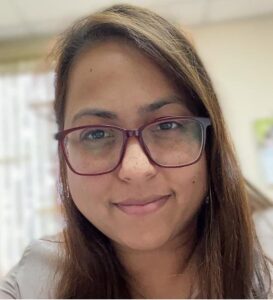 Racine is currently a Junior Research Fellow and PhD candidate (Volcanology) at the UWI Seismic Research Centre. Her PhD research aims to contribute to developing geothermal energy on Montserrat, a small island located in the northern section of the Lesser Antilles arc. Caribbean. She has two published journals in Geothermics. One which uses a joint geophysical application for improving on the structural classification of the Montserrat geothermal system and the other focused on developing the temperature and permeability regimes of the geothermal system using petrological findings from subsurface cores. Her responsibilities at the UWI-SRC involves monitoring ground deformation from the GPS network that consists of several stations on islands along the Lesser Antilles arc.
Racine is currently a Junior Research Fellow and PhD candidate (Volcanology) at the UWI Seismic Research Centre. Her PhD research aims to contribute to developing geothermal energy on Montserrat, a small island located in the northern section of the Lesser Antilles arc. Caribbean. She has two published journals in Geothermics. One which uses a joint geophysical application for improving on the structural classification of the Montserrat geothermal system and the other focused on developing the temperature and permeability regimes of the geothermal system using petrological findings from subsurface cores. Her responsibilities at the UWI-SRC involves monitoring ground deformation from the GPS network that consists of several stations on islands along the Lesser Antilles arc.
2. Geospatial Modeling for Socio-Environmental Sustainability
Heng Cai, Texas A&M University, hengcai@tamu.edu
Abstract: Increasingly frequent natural hazards and global environmental changes are huge challenges to human communities. Meanwhile, human activities are also changing the landscape of planet earth. Modeling and simulating human activities and environmental changes, and discovering their complex interactions are the keys to making informed decisions and thus building a sustainable future. In this presentation, Dr. Cai will introduce her work on mapping disaster risk and resilience inequalities and developing simulation models and tools for coastal land loss and population changes in response to climate change threats.
 Dr. Heng Cai is currently an Assistant Professor of Geography at Texas A&M University. She received her Ph.D. in Environmental Sciences from Louisiana State University in 2017. Dr. Cai’s research focuses on geographic information science, disaster resilience, and socio-environmental sustainability. Her research goal is to achieve a comprehensive understanding of the complex environmental and human systems through data mining, spatial modeling, and decision-making support tool development. Her work has been supported by the National Science Foundation (NSF), Texas A&M University, Louisiana Sea-Grant, and Coastal Protection and Restoration Authority (CPRA). Dr. Cai synthesizes various types of geospatial data to describe, model, and predict human activities and environmental changes, and their complex interactions facing threats from both recurrent natural hazards and long-lasting climate changes. Her work has been published in flagship Geography journals, including Annals of the American Association of Geographers, Remote Sensing of Environment, and International Journal of Digital Earth. For more information, please visit https://geography.tamu.edu/people/profiles/faculty/caiheng.html
Dr. Heng Cai is currently an Assistant Professor of Geography at Texas A&M University. She received her Ph.D. in Environmental Sciences from Louisiana State University in 2017. Dr. Cai’s research focuses on geographic information science, disaster resilience, and socio-environmental sustainability. Her research goal is to achieve a comprehensive understanding of the complex environmental and human systems through data mining, spatial modeling, and decision-making support tool development. Her work has been supported by the National Science Foundation (NSF), Texas A&M University, Louisiana Sea-Grant, and Coastal Protection and Restoration Authority (CPRA). Dr. Cai synthesizes various types of geospatial data to describe, model, and predict human activities and environmental changes, and their complex interactions facing threats from both recurrent natural hazards and long-lasting climate changes. Her work has been published in flagship Geography journals, including Annals of the American Association of Geographers, Remote Sensing of Environment, and International Journal of Digital Earth. For more information, please visit https://geography.tamu.edu/people/profiles/faculty/caiheng.html
3. Big Geospatial Data and GeoAI for Smart Disaster Resilience
Lei Zou, Texas A&M University, lzou@tamu.edu
Abstract: Due to the increasing incidence of natural hazards and population growth in hazard-prone areas, research and practices on improving disaster resilience have gained significant attention. Disaster resilience varies by location and can be vastly enhanced with real-time information describing on-site disaster impacts, which are difficult to obtain during natural hazards. Big geospatial data, e.g., location-based, real-time social and news media data, offer a unique lens to observe disaster impacts. However, extracting valuable, fine-grained geographical information from big geospatial data for disaster resilience improvement is challenging mainly because of technical difficulties in processing such big, biased, and noisy data. The breakthroughs in geographical artificial intelligence (GeoAI) provide solutions. This research elaborates on the opportunities of analyzing big geospatial data with GeoAI to support intelligent disaster resilience. Dr. Zou will introduce the use of geospatial big data and GeoAI to improve situational awareness, emergency rescue, and damage estimation through a few case studies.
 Lei Zou is an Assistant Professor in the Department of Geography and the director of the Geospatial Exploration & Resolution (GEAR) Lab at Texas A&M University. He received his Ph.D. in Environmental Sciences from Louisiana State University, a master’s degree from the Chinese Academy of Sciences, and a bachelor degree from Wuhan University. His research aims to build a sustainable future for human communities under the changing environment through spatial thinking, novel data, and intelligent algorithms. He has spearheaded a number of projects funded by the National Science Foundation, Department of Veteran Affairs, Texas A&M University, etc. These research circle around five research themes: (1) Big Geospatial Data and GeoAI for Disaster Management, (2) Urban Digital Twins for Coastal Sustainability, (3) Geospatial Approaches to Combating Health Crisis, (4) CyberGIS for Resilience Computation and Visualization, and (5) GIS for Humanities. Research outcomes from those projects have been published in over 40 publications. For more: https://geography.tamu.edu/people/profiles/faculty/zoulei.html. Lab website: https://www.geoearlab.com/.
Lei Zou is an Assistant Professor in the Department of Geography and the director of the Geospatial Exploration & Resolution (GEAR) Lab at Texas A&M University. He received his Ph.D. in Environmental Sciences from Louisiana State University, a master’s degree from the Chinese Academy of Sciences, and a bachelor degree from Wuhan University. His research aims to build a sustainable future for human communities under the changing environment through spatial thinking, novel data, and intelligent algorithms. He has spearheaded a number of projects funded by the National Science Foundation, Department of Veteran Affairs, Texas A&M University, etc. These research circle around five research themes: (1) Big Geospatial Data and GeoAI for Disaster Management, (2) Urban Digital Twins for Coastal Sustainability, (3) Geospatial Approaches to Combating Health Crisis, (4) CyberGIS for Resilience Computation and Visualization, and (5) GIS for Humanities. Research outcomes from those projects have been published in over 40 publications. For more: https://geography.tamu.edu/people/profiles/faculty/zoulei.html. Lab website: https://www.geoearlab.com/.
4. One Step Forward, Two Steps Back: Managing Floodplain Development in North Carolina
Hino, Miyuki, University of North Carolina at Chapel Hill, mhino@unc.edu
Abstract: Limiting housing and infrastructure in flood-prone places has long been recognized as critical to managing long-term risk. However, due to the difficulty of tracking development at small spatial scales, little empirical research has been conducted to explain differences between communities’ floodplain development patterns. We analyzed new construction across five million parcels in the State of North Carolina (USA) to develop standardized measures of floodplain development and evaluated the relationships between flood risk management effort and development outcomes. Results indicate that local development policies often run counter to efforts to limit long-term risk. Statewide, for every property removed through buyouts from 1996-2017, more than 10 new residences have been built in floodplains. At the community level, indicators of flood risk management effort (participation in the Community Rating System and use of buyouts) did not consistently align with floodplain development outcomes. Based on a sample of urban and suburban counties, we found over 75,000 acres of vacant floodplain land currently zoned for development. Land use planning and floodplain management have the potential to play a larger role in flood risk mitigation. Given extensive undeveloped floodplain land and projected climate change, additional effort to manage development is needed to limit increases in flood risk.
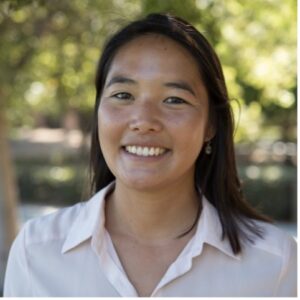 Miyuki Hino is an assistant professor in the Department of City and Regional Planning and an adjunct assistant professor in the Environment, Ecology, and Energy Program at the University of North Carolina at Chapel Hill. Her research aims to measure the social and economic impacts of climate hazards and analyze the effectiveness of climate change adaptation strategies. Recent work has focused on the impacts of coastal flooding and land use policy for climate change adaptation. Miyuki received a Ph.D. in Environment and Resources from Stanford University and a B.S. in Chemical Engineering from Yale University.
Miyuki Hino is an assistant professor in the Department of City and Regional Planning and an adjunct assistant professor in the Environment, Ecology, and Energy Program at the University of North Carolina at Chapel Hill. Her research aims to measure the social and economic impacts of climate hazards and analyze the effectiveness of climate change adaptation strategies. Recent work has focused on the impacts of coastal flooding and land use policy for climate change adaptation. Miyuki received a Ph.D. in Environment and Resources from Stanford University and a B.S. in Chemical Engineering from Yale University.
Friday, February 11, 2022, 1:00 to 2:00 p.m. CT
1. Wildfire Damage in Wildland Urban Interface Communities
Negar Elhami-Khorasani, negarkho@buffalo.edu
Abstract: Wildfires have been part of the natural landscape for a healthy ecosystem, yet these fires are projected to become more frequent and intense due to changing weather patterns and anthropogenic activities. Destructive wildfires are now a real threat in regions across the country and beyond what was once considered as the fire season, examples of which are the 2016 Gatlinburg Fire in the Southeast and the 2021 Marshall Fire in late December. Existing wildfire risk assessment procedures rely primarily on exposure and historical data to prioritize wildland-urban interface communities, without simulating the community response. The existing tools cannot be used to evaluate the effect of different mitigation or preparedness actions, such as fire-resilient constructions or defensible spaces, on reducing wildfire losses for a specific community. This presentation provides an overview of a streamlined approach to capture wildfire spread inside wildland-urban interface communities. The proposed approach can be extended to study the effects of different intervention programs on wildfire damage inside a community.
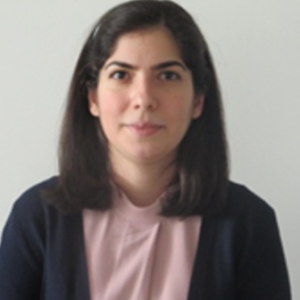 Negar Elhami-Khorasani is an Associate Professor in the Department of Civil, Structural and Environmental Engineering at the University at Buffalo. Her primary areas of research are structural fire engineering, performance-based design and reliability analysis of structures at high temperatures, resilience of communities under extreme hazards including wildfires and earthquakes, characterization of cascading multi-hazard events, such as post-earthquake fires, and their effects on structures and communities. The outcomes of her research enhance safety by developing codes and guidelines, and minimize losses by optimizing mitigation, preparedness, and response strategies. Elhami-Khorasani is the co-chair of the ASCE/SEI Fire Protection Committee. She is also a member of the International Federation for Structural Concrete (fib) Task Group on Fire Design of Concrete Structures, as well as the International Association for Fire Safety Science (IAFSS) Large Outdoor Fires and the Built Environment working groups. Her research has been funded by the United States Geological Survey, National Fire Protection Association, ASCE Structural Engineering Institute, Charles Pankow Foundation, National Science Foundation, and Department of Transportation.
Negar Elhami-Khorasani is an Associate Professor in the Department of Civil, Structural and Environmental Engineering at the University at Buffalo. Her primary areas of research are structural fire engineering, performance-based design and reliability analysis of structures at high temperatures, resilience of communities under extreme hazards including wildfires and earthquakes, characterization of cascading multi-hazard events, such as post-earthquake fires, and their effects on structures and communities. The outcomes of her research enhance safety by developing codes and guidelines, and minimize losses by optimizing mitigation, preparedness, and response strategies. Elhami-Khorasani is the co-chair of the ASCE/SEI Fire Protection Committee. She is also a member of the International Federation for Structural Concrete (fib) Task Group on Fire Design of Concrete Structures, as well as the International Association for Fire Safety Science (IAFSS) Large Outdoor Fires and the Built Environment working groups. Her research has been funded by the United States Geological Survey, National Fire Protection Association, ASCE Structural Engineering Institute, Charles Pankow Foundation, National Science Foundation, and Department of Transportation.
2. Post-Earthquake Community Functionality Analysis
Ram Krishna Mazumder, rkmazumder@ku.edu
Abstract: Recent disasters have shown that service disruption can lead to building occupant fatality, especially for the most vulnerable populations. However, building design codes focus on preventing collapse and reducing structural damage and do not specify requirements for reducing functionality loss caused by service disruptions. To assess community resilience, the functionality analysis of buildings should holistically integrate interdependencies with infrastructure systems, as well as utility availability, and physical accessibility to the road network. Dr. Mazumder will discuss a framework for post-earthquake community functionality analysis by modeling building functionality restoration that integrates essential services and system interdependency. The framework also accounts for the impact of demand changes on the water network due to household dislocation to model the realistic performance of the water network under stressed conditions during recovery. The presentation will conclude with an illustration of the framework to a virtual testbed community of Centerville.
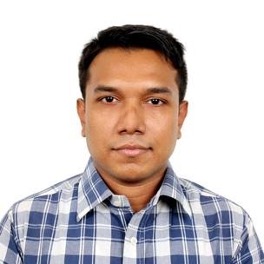 Dr. Ram Krishna Mazumder is a Postdoctoral Researcher for the NIST Center of Excellence for Risk-Based Community Resilience Planning in the Department of Civil, Environmental, and Architectural Engineering at the University of Kansas, advised by Prof. Sutley. His research primarily focuses on risk management of critical civil infrastructure systems subjected to natural hazards and community disaster resilience analysis. Dr. Mazumder obtained his Ph.D. in Civil Engineering from Case Western Reserve University; his doctoral research focused on Risk-based Asset Management of Water Distribution Systems. Dr. Mazumder holds a Postgraduate Diploma in Geological and Climate-Related Risk from the University of Geneva, and an MS in Earthquake Engineering from the Sapienza University of Rome. Dr. Mazumder is an Associated Editor of ASCE Journal of Pipeline System Engineering and Practice. If you are interested in learning more about his research, please visit https://rxm562.github.io/.
Dr. Ram Krishna Mazumder is a Postdoctoral Researcher for the NIST Center of Excellence for Risk-Based Community Resilience Planning in the Department of Civil, Environmental, and Architectural Engineering at the University of Kansas, advised by Prof. Sutley. His research primarily focuses on risk management of critical civil infrastructure systems subjected to natural hazards and community disaster resilience analysis. Dr. Mazumder obtained his Ph.D. in Civil Engineering from Case Western Reserve University; his doctoral research focused on Risk-based Asset Management of Water Distribution Systems. Dr. Mazumder holds a Postgraduate Diploma in Geological and Climate-Related Risk from the University of Geneva, and an MS in Earthquake Engineering from the Sapienza University of Rome. Dr. Mazumder is an Associated Editor of ASCE Journal of Pipeline System Engineering and Practice. If you are interested in learning more about his research, please visit https://rxm562.github.io/.
3. Data Regression Framework for Time Series Data with Extreme Events
Rui Wu, wur18@ecu.edu
Abstract: Time series data are significant to scientific, social, economic, and other areas, such as the prediction of weather changes being instrumental for administrative decision-making. In recent years, deep learning methods have achieved great success in time series prediction when compared with classic machine learning methods. However, because time series data can dynamically change and the correlations between the target variable and other features can also vary, making predictions using time series data is often challenging. To further improve existing machine learning and deep learning models for time series prediction, we propose a framework to integrate machine learning models with anomaly detection algorithms. The extreme events are highlighted so the machine learning models can process them appropriately. We conducted extensive experiments on real world datasets ranging in size from a few hundred to more than ten thousand records. The experimental results demonstrate that our proposed framework significantly improves machine learning model accuracy and mitigates the accuracy descending rate when the predicting horizon (i.e., the number of timestamps ahead) increases.
 Rui Wu received a Bachelor degree in Computer Science and Technology from Jilin University, China in 2013. He then went on and received his Master and Ph.D. degrees in Computer Science and Engineering from the University of Nevada, Reno in 2015 and 2018, respectively. Rui is now working as an assistant professor in the Department of Computer Science at East Carolina University and collaborates with geological and hydrological scientists to protect the ecological system. His main research interests are data imputation, machine learning, and data visualization using AR/VR devices.
Rui Wu received a Bachelor degree in Computer Science and Technology from Jilin University, China in 2013. He then went on and received his Master and Ph.D. degrees in Computer Science and Engineering from the University of Nevada, Reno in 2015 and 2018, respectively. Rui is now working as an assistant professor in the Department of Computer Science at East Carolina University and collaborates with geological and hydrological scientists to protect the ecological system. His main research interests are data imputation, machine learning, and data visualization using AR/VR devices.
4. Validated Expert and Empirical Damage Functions Reveal Severely Diverging Economic Consequences to High-Resolution Depth Exposures Across the United States
Adam Pollack, abpoll@bu.edu
Abstract: Expert-based inundation damage functions (IDFs) in the United States are ubiquitous but scarcely validated. We develop empirical IDFs and externally validate both sets of IDFs from data on 689,018 assessed damages from 441 flood events spanning a 40-year period. We then apply similarly unbiased IDFs to high-resolution structure and hazard data for >70M single family homes across the coterminous U.S. (CONUS). Relative to the expert IDFs, empirical alternatives exhibit less convexity, predicting larger losses at low inundations that occur at higher frequency, but smaller losses at comparatively rare high inundations. Thus, empirical IDFs project CONUS-wide expected annual losses of $20.5B, over twice as large as those based on expert IDFs. Of the $10.5B difference, >$300M is accounted for by 1.1M (12%) properties with low depth exposures that expert IDFs treat as undamaged and >$4B is accounted for by 5.2M properties (65%) facing inundations up to 3 ft. relative to grade. Divergences are driven by the interaction of uncertainties surrounding the first-floor elevation of structures and losses incurred from near grade inundations which vary significantly over space and lead to a 4.6B (135%) difference in the Southeast Atlantic and $655M (214%) difference in the Midwest.
 Adam Pollack is a PhD Candidate in the Department of Earth and Environment in Boston University. His dissertation comprises two broad areas of research to help ensure that flood risk management isn’t biased against those most vulnerable to flood impacts. In the first, a U.S.-wide, property level flood risk estimation data system is developed and queried to quantify, and reduce where possible, bias and uncertainty in methods that inform research and policy. In the second, techniques in causal inference are employed to understand socio-environmental relationships that help inform opportunities for effective and equitable flood risk interventions and management. Adam currently has two first-authored papers in review, one in preparation, and supports five collaborations based on his flood risk system. His research agenda aims to make the flood risk system more accurate, precise and portable and is exploring expansion to other sectors and hazards. He’s always eager to collaborate across disciplines and support cost effective and socially equitable natural disaster management research.
Adam Pollack is a PhD Candidate in the Department of Earth and Environment in Boston University. His dissertation comprises two broad areas of research to help ensure that flood risk management isn’t biased against those most vulnerable to flood impacts. In the first, a U.S.-wide, property level flood risk estimation data system is developed and queried to quantify, and reduce where possible, bias and uncertainty in methods that inform research and policy. In the second, techniques in causal inference are employed to understand socio-environmental relationships that help inform opportunities for effective and equitable flood risk interventions and management. Adam currently has two first-authored papers in review, one in preparation, and supports five collaborations based on his flood risk system. His research agenda aims to make the flood risk system more accurate, precise and portable and is exploring expansion to other sectors and hazards. He’s always eager to collaborate across disciplines and support cost effective and socially equitable natural disaster management research.
5. Heat Hurts: Subjective Heat Stress Impacts in South Florida
Meenakshi Jerath Chabba, mjerath@fiu.edu
Abstract: Extreme heat presents an unprecedented challenge to South Florida residents as the region is expected to experience more than 150 days per year of heat index 105°F in the RCP8.5 scenario (Dahl et al. 2019). The chronic and extreme nature of heat, as experienced in coastal tropical areas such as South Florida, poses a unique public health challenge, threatening physical and mental health, at-work and at-home productivity, quality of life and people’s wellbeing (Kovats and Hajat 2008; Arifwidodo et al. 2019, 2020, Oppermann et al. 2021). An invisible and silent risk, extreme heat disproportionately affects marginalized populations such as low-income groups, communities of color, the elderly, pregnant, people with pre-existing illnesses and comorbidities, the linguistically isolated, and outdoor work labor, revealing the stark inequities of urban heat impacts (Hamstead et al., 2018; Zander et al., 2019). Using tri-county wide surveys, this research explores the self-reported heat stress experience of diverse South Florida populations, including outdoor workers, and farmworkers in particular. Research findings include the impact of heat stress on health, subjective wellbeing, and work-related productivity, revealing different variables that influence heat stress among diverse South Florida residents.
Meenakshi i s a Ph.D. Candidate at Florida International University (FIU) working in the transdisciplinary fields of Environmental Studies, Disaster Risk Management, and Ecological Economics. Her dissertation examines risk and sustainable solutions in two diverse global urban areas, Lima Metropolitan and South Florida, investigating how societies can transition toward social-ecological wellbeing, resilience, and sustainability outcomes using integrative, just, and equitable solutions. Meenakshi works full-time at the Extreme Events Institute at FIU, working on research and capacity building for disaster risk management in the Latin American and Caribbean (LAC) region. She designs and conducts outreach and training workshops in economic analysis of risk reduction projects for disaster risk managers, academicians, national emergency officers, and NGO personnel in the LAC region. She has performed economic evaluation of approximately 20 USAID and DFID-funded measures in the LAC region. As an adjunct faculty at FIU, she has taught undergraduate courses in Ecology. As part of an expert committee funded by The Miami Fund, she is formulating an alternative approach to include equity and environmental outcomes in the benefit-cost analysis of resilience projects. She is an active member of the Urban Heat Resource Group of South Florida, a collective of scientists and practitioners in the region.
s a Ph.D. Candidate at Florida International University (FIU) working in the transdisciplinary fields of Environmental Studies, Disaster Risk Management, and Ecological Economics. Her dissertation examines risk and sustainable solutions in two diverse global urban areas, Lima Metropolitan and South Florida, investigating how societies can transition toward social-ecological wellbeing, resilience, and sustainability outcomes using integrative, just, and equitable solutions. Meenakshi works full-time at the Extreme Events Institute at FIU, working on research and capacity building for disaster risk management in the Latin American and Caribbean (LAC) region. She designs and conducts outreach and training workshops in economic analysis of risk reduction projects for disaster risk managers, academicians, national emergency officers, and NGO personnel in the LAC region. She has performed economic evaluation of approximately 20 USAID and DFID-funded measures in the LAC region. As an adjunct faculty at FIU, she has taught undergraduate courses in Ecology. As part of an expert committee funded by The Miami Fund, she is formulating an alternative approach to include equity and environmental outcomes in the benefit-cost analysis of resilience projects. She is an active member of the Urban Heat Resource Group of South Florida, a collective of scientists and practitioners in the region.
Friday, May 13, 2022, 1:00 to 2:00 p.m. CT
1. Post-Earthquake Housing Recovery Using Agent-Based Modeling
Rodrigo Costa, rccosta@stanford.edu
Abstract: Effective recovery from future disasters requires careful planning today. At present, pre-planning focuses largely on reducing immediate losses, with less emphasis on actions to improve the recovery process. When long-term recovery is accounted for, this is done by reviewing past disasters in other communities. While this is valuable, it cannot incorporate unique community contexts, or address important but previously unobserved challenges. Without pre-planning, decisions regarding recovery need to be taken in a chaotic post-disaster scenario, being pressured by the need to act quickly to restore some sense of normalcy. These rushed decisions may fail to comprehensively evaluate the needs of the community. Disaster recovery simulation models can provide valuable insights for planners, allowing ‘what-if’ scenarios to be investigated, and supplementing best practices learned from previous disasters. However, developing a detailed recovery model for a community can be a daunting task. This presentation will present recent developments in the use of agent-based methods to simulate the long-term impacts of earthquakes to communities, with focus on post-earthquake housing recovery. A case study focusing on the city of San Francisco will be presented, showing that agent-based models can provide insights on post-disaster unmet housing needs, recovery rates, identify bottlenecks for recovery, and evaluate the potential of population losses during the recovery process.
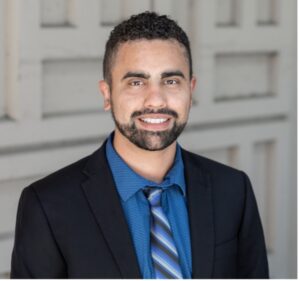 Rodrigo Costa is a post-doctoral scholar at the Stanford Urban Resilience Initiative. Rodrigo’s research examines how communities’ physical, economic, and social systems interact to exacerbate disaster risk and further socioeconomic and racial inequalities. Rodrigo works at the interface between engineering and social sciences. Outside of his academic research, he collaborates with emergency managers, urban planners, resilience officers, and insurance companies to further understanding of disaster risks. Rodrigo’s goal is to inform targeted interventions to reduce disaster impacts, accelerate recovery, and ensure that all of society participates in the benefits.
Rodrigo Costa is a post-doctoral scholar at the Stanford Urban Resilience Initiative. Rodrigo’s research examines how communities’ physical, economic, and social systems interact to exacerbate disaster risk and further socioeconomic and racial inequalities. Rodrigo works at the interface between engineering and social sciences. Outside of his academic research, he collaborates with emergency managers, urban planners, resilience officers, and insurance companies to further understanding of disaster risks. Rodrigo’s goal is to inform targeted interventions to reduce disaster impacts, accelerate recovery, and ensure that all of society participates in the benefits.
2. Towards the Integration of Socioeconomic Impact and Recovery Modeling into High-Resolution Regional Disaster Simulations
Adam Zsarnoczay, adamzs@stanford.edu
Abstract: Conventional methods in regional disaster risk assessment, such as the Hazus methodology, are complemented today by higher-resolution approaches that aspire to make features developed for performance-based design and assessment of individual structures available in regional-scale disaster simulations. Computational and human resources required for such advanced simulations are expected to decrease rapidly in the next few years, making them widely available in both research and practice. However, disaster simulations should go farther and investigate the consequences of such damages in the context of how communities are expected to respond and recover. Such an extension presents challenges from both a data and a modeling perspective. The NSF-supported NHERI Computational Modeling and Simulation Center (SimCenter) has been integrating models and data from the physical sciences and engineering into computational workflows to help advance new lines of research in natural hazards engineering. This presentation highlights the two primary thrusts that we pursue to expand our framework to the social sciences and support quantitative assessment of the recovery and resilience of communities: i) robust and standardized workflows for high-resolution regional disaster simulation to foster sharing and re-use of research outputs, and ii) publicly available, rich, high-resolution data on the built environment and population demographics.
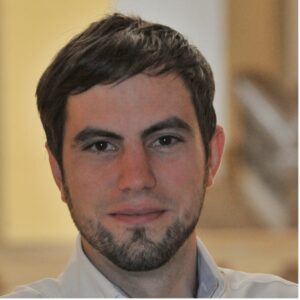 Adam Zsarnóczay is a Research Engineer at the John A. Blume Earthquake Engineering Center at Stanford University, where his work focuses on disaster simulations that support multi-hazard risk assessment and management at a regional scale. At the NHERI SimCenter, Dr. Zsarnóczay is the Associate Director for Research Outreach. Dr. Zsarnóczay completed his Ph.D. in civil engineering at the Budapest University of Technology and Economics, where he was also an Assistant Professor. He has research experience working at scales that range from an individual structural member through a building up to cities with hundreds of thousands of assets. His research interests include probabilistic natural hazard assessment, model development and calibration for structural response estimation and performance assessment, and uncertainty quantification in large-scale, regional simulations.
Adam Zsarnóczay is a Research Engineer at the John A. Blume Earthquake Engineering Center at Stanford University, where his work focuses on disaster simulations that support multi-hazard risk assessment and management at a regional scale. At the NHERI SimCenter, Dr. Zsarnóczay is the Associate Director for Research Outreach. Dr. Zsarnóczay completed his Ph.D. in civil engineering at the Budapest University of Technology and Economics, where he was also an Assistant Professor. He has research experience working at scales that range from an individual structural member through a building up to cities with hundreds of thousands of assets. His research interests include probabilistic natural hazard assessment, model development and calibration for structural response estimation and performance assessment, and uncertainty quantification in large-scale, regional simulations.
3. Individual Choices and Disease Modeling
Wisdom Avusuglo, avusuglo@yorku.ca
Abstract: The damage caused by infectious diseases since the dawn of mankind cannot be overemphasized—infectious diseases undermine health, economies, and social life. In the wake of infectious diseases, some kinds of infectious diseases enter the human population and vanish progressively with time, but other kinds of infectious diseases enter and stay in the population, hence, the need for the study of infectious diseases transmission and control is ever pressing. Mathematical Disease Models (MDM) have been instrumental in providing insightful approaches to contain these diseases. An aspect that is often ignored in these modelling frameworks is individual responses to the policy prescriptions by these models. To bridge this gap is the emergence of economic epidemiological modelling—incorporating economic incentives into mathematical disease models. This talk presents an overview of a compartmental economic epidemiological model. We make a case of how individual behavioral responses to disease transmission impacts disease prevalence. The talk will also present my current proposed project with the IDRC Research Team.
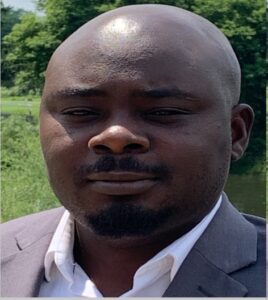 Wisdom Stallone Avusuglo is an IDRC-sponsored postdoctoral fellow. He is an executive member of the Africa Canada Artificial Intelligence and Data Innovation Consortium, York University. He obtained his Ph.D. in Statistics, University of Western Ontario and Master’s in Applied Modelling and Quantitative Methods, Trent University. His research interest spans across Applied Probability and Statistics; Financial Risk Management; Infectious Disease Modelling; Applied Dynamic Optimization to Economic Epidemiology.
Wisdom Stallone Avusuglo is an IDRC-sponsored postdoctoral fellow. He is an executive member of the Africa Canada Artificial Intelligence and Data Innovation Consortium, York University. He obtained his Ph.D. in Statistics, University of Western Ontario and Master’s in Applied Modelling and Quantitative Methods, Trent University. His research interest spans across Applied Probability and Statistics; Financial Risk Management; Infectious Disease Modelling; Applied Dynamic Optimization to Economic Epidemiology.
4. Environmental Justice and Flood Hazards: Future Research Directions
Aaron Flores, aaron.b.flores@utah.edu
Abstract: Interest in the distributional environmental injustices associated with flooding emerged after Hurricane Katrina in 2005. Areas of Louisiana and Mississippi that were heavily damaged were disproportionately home to African Americans and lower socioeconomic status groups. Since Katrina, other studies of Sandy and Harvey have also documented inequitable impacts based on minority race/ethnicity, low socioeconomic status, and other indicators of social disadvantage. Studies that focus on modeled flood risk (e.g., 100-year flood risk) have less consistently observed social inequities, and researchers have criticized federal maps that inform flood risk management in the United States. Using state-of-the-art flood modeling and dasymetric mapping, Aaron’s research indicates that millions of residents in the United States live at risk to 100-year flooding outside of federally-delineated flood zones and that racial/ethnic minority and low socioeconomic status groups experience disproportionate risk in these zones. Despite the improvements in flood risk data and our understanding of who is most at risk, less is known about environmental justice in relation to investments in structural and non-structural forms of flood protection. Aaron’s talk will focus on these topics and provide potential future research directions for environmental justice studies focused on flood hazards.
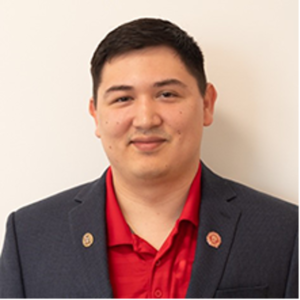 Aaron Flores is a human-environmental geographer focused on the social dimensions of hazards and disasters. He earned his PhD in the Department of Geography at the University of Utah (UU) and is a Presidential Postdoctoral Fellow in the School of Geographical Sciences & Urban Planning at Arizona State University (as of August 2022). His research has examined social vulnerability, environmental justice, and health disparities in the context of hazards and disasters, with a focus on the human dimensions of flooding, extreme heat, and air pollution in the United States (US). During his first two years at the UU, he investigated the social vulnerability and environmental justice dimensions of Hurricane Harvey (2017). This work documented the disproportionate impacts of Harvey on racial/ethnic minority and low socioeconomic status groups in Greater Houston, Texas, in terms of flood exposures, adverse event experiences, and post-disaster recovery. In 2020, he earned the prestigious Ford Foundation Predoctoral Fellowship from the National Academies of Sciences, Engineering, and Medicine.
Aaron Flores is a human-environmental geographer focused on the social dimensions of hazards and disasters. He earned his PhD in the Department of Geography at the University of Utah (UU) and is a Presidential Postdoctoral Fellow in the School of Geographical Sciences & Urban Planning at Arizona State University (as of August 2022). His research has examined social vulnerability, environmental justice, and health disparities in the context of hazards and disasters, with a focus on the human dimensions of flooding, extreme heat, and air pollution in the United States (US). During his first two years at the UU, he investigated the social vulnerability and environmental justice dimensions of Hurricane Harvey (2017). This work documented the disproportionate impacts of Harvey on racial/ethnic minority and low socioeconomic status groups in Greater Houston, Texas, in terms of flood exposures, adverse event experiences, and post-disaster recovery. In 2020, he earned the prestigious Ford Foundation Predoctoral Fellowship from the National Academies of Sciences, Engineering, and Medicine.
5. Flood Risk Capitalization and Potential Consequences of Overvaluation in U.S. Housing Markets
Jesse Gourevitch, jgourevi@wharton.upenn.edu
Abstract: In light of more comprehensive estimates of flood risk in the present and under future climate change, there is growing concern that flood zone property prices do not reflect the costs of exposure to flood risk. If the costs of flooding become realized in the real estate market, then homeowners are at risk of losing value in their most significant asset – their home. Here, we develop a hedonic model to estimate the empirical effects of flood risk on property sale prices in the US, accounting for county-level heterogeneity in the magnitude of these estimates. We calculate potential overvaluation of properties located in the flood zone as the difference between their current fair market value and their estimated “efficient” market value, factoring in the net present value of expected property-level flood damages over a 30-year time horizon. We find that the prices of flood zone properties are discounted between 1% and 9%. Price discounts are generally lower in coastal counties that are not subject to disclosure laws and where there is less concern about climate change. In these counties, flood zone properties are on average overvalued by more than 50%. In aggregate, we estimate that flood zone properties in the US are potentially overvalued by up to $300 billion. This analysis illuminates the potential consequences of the devaluation of floodplain real estate for homeowners, mortgage lenders, and municipalities. It also gives policymakers who are engaged in developing climate adaptation policies critical information about the economic costs of climate change, and raises questions about how those costs ought to be distributed within the US.
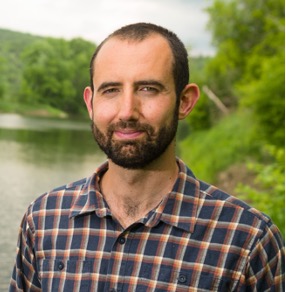 Jesse is a postdoctoral research fellow at the Wharton Risk Center at the University of Pennsylvania and the Department of Earth and Planetary Sciences at the University of California – Davis. His research aims to understand the relationships among climate and land use change, ecological and hydrological processes, and economic and human health outcomes. Underlying this work is a broad interest in how the impacts of climate and land use change are distributed among different demographic and socioeconomic groups, and in turn, how public policy can achieve more equitable outcomes. Currently Jesse’s research examines the impacts of increasing flood risk on US housing markets and municipal finance, and the effectiveness of federal programs designed to reduce flood damages, such as the FEMA’s Community Rating System. Jesse earned his PhD in Natural Resources from the University of Vermont in 2021 and his B.A. in environmental studies from Carleton College in 2014.
Jesse is a postdoctoral research fellow at the Wharton Risk Center at the University of Pennsylvania and the Department of Earth and Planetary Sciences at the University of California – Davis. His research aims to understand the relationships among climate and land use change, ecological and hydrological processes, and economic and human health outcomes. Underlying this work is a broad interest in how the impacts of climate and land use change are distributed among different demographic and socioeconomic groups, and in turn, how public policy can achieve more equitable outcomes. Currently Jesse’s research examines the impacts of increasing flood risk on US housing markets and municipal finance, and the effectiveness of federal programs designed to reduce flood damages, such as the FEMA’s Community Rating System. Jesse earned his PhD in Natural Resources from the University of Vermont in 2021 and his B.A. in environmental studies from Carleton College in 2014.
Friday, August 12, 2022, 1:00 to 2:00 p.m. CT
1. Making Room for the River: Applying a Plan Integration for Resilience Scorecard to a Network of Plans in Nijmegen, the Netherlands
Siyu Yu, yusiyu_1989@tamu.edu
Assistant Professor, Department of Landscape Architecture and Urban Planning, Texas A&M
Abstract: In this study we analyze plan integration for flood resilience in the city of Nijmegen, the site of the largest Room for the River project in The Netherlands. Little is known about the degree to which local and regional plans are coordinated with the national Room for the River program or about the cumulative influence of plans on flood vulnerability. To effectively investigate these issues, we use and build upon the Plan Integration for Resilience Scorecard™(PIRS) concept and method, which analyzes the consistency and effects of networks of plans on community vulnerability. We expand the scope to include plans from multiple administrative scales and the focus to include environmental vulnerability. Using a three-phase evaluation process, we demonstrate that Room for the River policies are well integrated in Nijmegen’s network of plans, particularly with respect to flood safety and natural protection. However, we also find that policies at different administrative scales lack consistency in some places, some socially vulnerable neighborhoods receive comparatively little policy attention, and local plans often prioritize development over flood resilience, though higher tier plans sometimes make up for these policy gaps. Flood resilience is still finding its way in the Dutch planning system.
 Siyu Yu is an Assistant Professor in the Department of Landscape Architecture and Urban Planning and a core faculty with the Hazard Reduction and Recovery Center at Texas A&M University. Her experience spans land use, plan integration, and resilience issues in the United States, the Netherlands, and Japan. Much of Dr. Yu’s current research focuses on the development, application, and extension of the Plan Integration for Resilience Scorecard™(PIRS) evaluation methodology. The aim of this research is to better understand relationships among networks of land use and development plans and policies, and social and physical vulnerability to hazards and climate change. Her research has been published in the Journal of the American Planning Association, Journal of Planning Education and Research, Landscape and Urban Planning, and the Journal of Environmental Planning and Management. Before arriving at Texas A&M, she worked as a senior urban planner at the Urban Planning and Design Institute of Shenzhen, China. She holds a Ph.D. in Urban and Regional Science from Texas A&M University and is certified by the American Institute of Certified Planners. Her research has been funded by the U.S. Department of Homeland Security (DHS), the National Science Foundation (NSF), and the National Academies.
Siyu Yu is an Assistant Professor in the Department of Landscape Architecture and Urban Planning and a core faculty with the Hazard Reduction and Recovery Center at Texas A&M University. Her experience spans land use, plan integration, and resilience issues in the United States, the Netherlands, and Japan. Much of Dr. Yu’s current research focuses on the development, application, and extension of the Plan Integration for Resilience Scorecard™(PIRS) evaluation methodology. The aim of this research is to better understand relationships among networks of land use and development plans and policies, and social and physical vulnerability to hazards and climate change. Her research has been published in the Journal of the American Planning Association, Journal of Planning Education and Research, Landscape and Urban Planning, and the Journal of Environmental Planning and Management. Before arriving at Texas A&M, she worked as a senior urban planner at the Urban Planning and Design Institute of Shenzhen, China. She holds a Ph.D. in Urban and Regional Science from Texas A&M University and is certified by the American Institute of Certified Planners. Her research has been funded by the U.S. Department of Homeland Security (DHS), the National Science Foundation (NSF), and the National Academies.
2. Connected Water Models, An Approach from Coasts
Shintaro Bunya, sbunya@unc.edu
Research Scientist, DHS Coastal Resilience Center of Excellence, UNC Center for Natural Hazards Resilience, The University of North Carolina at Chapel Hill
One of the recent active areas of research in flood risk evaluation is compound flooding, in which multiple sources of flooding occur at the same time at the same location. In hurricane events, water from an open ocean is driven by winds and atmospheric pressure to cause storm surges while the preceding/concurrent heavy rainfall brings pluvial and fluvial floods. The factors that may increase or reduce the extent of the different types of floods are different from each other. That is why these flooding sources have been modeled independently and that is why connecting the models is challenging. In this presentation, our recent efforts to develop a numerical simulation model for compound flooding due to fluvial and coastal sources are introduced. The presenter welcomes discussions on how the information produced by the new model contributes to raising resilience and what information is actually needed for the same purpose by communities.
 Dr. Shintaro Bunya is a Research Scientist at the Center for Natural Hazards Resilience of the University of North Carolina at Chapel Hill. He investigates Hurricane storm surges to contribute to the resilience of the coastal communities. He is one of the main contributors to the ADCIRC storm surge prediction model, which is a computer model extensively used for the past decades by multiple academic institutes, governmental organizations, and industries. He received Ph.D. from The University of Tokyo in 2005. He was a visiting assistant professor from 2005 to 2007 at the University of Notre Dame, and an assistant professor at the University of Tokyo from 2007 to 2009. In 2009, he joined a think tank company in Japan where he worked for government agencies and industry. He joined UNC-Chapel Hill in 2021. Throughout his career he participated in the recovery efforts from two major natural disasters: Hurricane Katrina in 2005 and the Great East Japan Earthquake and Tsunami in 2011. He has engaged in numerous projects related to storm surges, tsunamis, other flood events, and climate change mitigation and adaptation.
Dr. Shintaro Bunya is a Research Scientist at the Center for Natural Hazards Resilience of the University of North Carolina at Chapel Hill. He investigates Hurricane storm surges to contribute to the resilience of the coastal communities. He is one of the main contributors to the ADCIRC storm surge prediction model, which is a computer model extensively used for the past decades by multiple academic institutes, governmental organizations, and industries. He received Ph.D. from The University of Tokyo in 2005. He was a visiting assistant professor from 2005 to 2007 at the University of Notre Dame, and an assistant professor at the University of Tokyo from 2007 to 2009. In 2009, he joined a think tank company in Japan where he worked for government agencies and industry. He joined UNC-Chapel Hill in 2021. Throughout his career he participated in the recovery efforts from two major natural disasters: Hurricane Katrina in 2005 and the Great East Japan Earthquake and Tsunami in 2011. He has engaged in numerous projects related to storm surges, tsunamis, other flood events, and climate change mitigation and adaptation.
3. One Step Forward, Two Steps Back: Managing Floodplain Development in North Carolina
Hino, Miyuki, mhino@unc.edu
Limiting housing and infrastructure in flood-prone places has long been recognized as critical to managing long-term risk. However, due to the difficulty of tracking development at small spatial scales, little empirical research has been conducted to explain differences between communities’ floodplain development patterns. We analyzed new construction across five million parcels in the State of North Carolina (USA) to develop standardized measures of floodplain development and evaluated the relationships between flood risk management effort and development outcomes. Results indicate that local development policies often run counter to efforts to limit long-term risk. Statewide, for every property removed through buyouts from 1996-2017, more than 10 new residences have been built in floodplains. At the community level, indicators of flood risk management effort (participation in the Community Rating System and use of buyouts) did not consistently align with floodplain development outcomes. Based on a sample of urban and suburban counties, we found over 75,000 acres of vacant floodplain land currently zoned for development. Land use planning and floodplain management have the potential to play a larger role in flood risk mitigation. Given extensive undeveloped floodplain land and projected climate change, additional effort to manage development is needed to limit increases in flood risk.
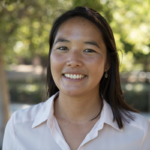 Miyuki Hino is an assistant professor in the Department of City and Regional Planning and an adjunct assistant professor in the Environment, Ecology, and Energy Program at the University of North Carolina at Chapel Hill. Her research aims to measure the social and economic impacts of climate hazards and analyze the effectiveness of climate change adaptation strategies. Recent work has focused on the impacts of coastal flooding and land use policy for climate change adaptation. Miyuki received a Ph.D. in Environment and Resources from Stanford University and a B.S. in Chemical Engineering from Yale University.
Miyuki Hino is an assistant professor in the Department of City and Regional Planning and an adjunct assistant professor in the Environment, Ecology, and Energy Program at the University of North Carolina at Chapel Hill. Her research aims to measure the social and economic impacts of climate hazards and analyze the effectiveness of climate change adaptation strategies. Recent work has focused on the impacts of coastal flooding and land use policy for climate change adaptation. Miyuki received a Ph.D. in Environment and Resources from Stanford University and a B.S. in Chemical Engineering from Yale University.
4. The National Disaster Medical System (NDMS) Pilot Program, Military-Civilian NDMS Interoperability Study (MCNIS)
Gill, Kimberly, kimberly.gill.ctr@usuhs.edu
The definitive care component of the National Disaster Medical System (NDMS) may not be able to effectively manage tens of thousands of casualties resulting from a catastrophic incident or overseas conflict. To address this potential national security threat, Congress authorized the U.S. Secretary of Defense and supporting federal agencies to conduct the NDMS Pilot program (“Pilot”) to improve the interoperability, special capabilities, and patient capacity of the NDMS. This research reports the results of the Military-Civilian NDMS Interoperability Study (MCNIS), a three-step, mixed-methods study designed to inform the current implementation phase of the Pilot program. In the first phase of MCNIS, researchers conducted a series of facilitated discussions with 49 key NDMS federal and civilian (private sector) stakeholders to identify and assess weaknesses and opportunities for improvement of the NDMS (Kirsch et al., 2022). Next, the findings of the facilitated discussions were prioritized and validated through a web-based quantitative survey completed by 87 respondents representing Federal government agencies, Federal Coordinating Centers (FCC), and civilian (private sector) NDMS stakeholders. Lastly, a stakeholder engagement consensus meeting was held to form real-time, electronic rank-ordering of the MCNIS findings and to establish initial priorities for NDMS Pilot program implementation.
 Kimberly B. Gill, Ph.D. is a sociologist with 20 years of research, evaluation, teaching and applied experience in the public health aspects of disaster. Dr. Gill serves as Senior Research Scientist III for the National Disaster Medical System (NDMS) Pilot Program at the National Center for Disaster Medicine and Public Health (NCDMPH), Uniformed Services University of the Health Sciences (USUHS) / Henry M. Jackson Foundation for the Advancement for Military Medicine (HJF) in Bethesda, MD.
Kimberly B. Gill, Ph.D. is a sociologist with 20 years of research, evaluation, teaching and applied experience in the public health aspects of disaster. Dr. Gill serves as Senior Research Scientist III for the National Disaster Medical System (NDMS) Pilot Program at the National Center for Disaster Medicine and Public Health (NCDMPH), Uniformed Services University of the Health Sciences (USUHS) / Henry M. Jackson Foundation for the Advancement for Military Medicine (HJF) in Bethesda, MD.
Prior to this role, Dr. Gill served as Research Associate Scientist for the Disaster Research Center at the University of Delaware. There she worked on COPEWELL, Composite of Post-Event Well-Being, an evidence-based model and collection of tools that address community resilience as it pertains to disasters. Earlier in her career, Dr. Gill served as the Program Manager for the Center for Public Health Preparedness (CPHP) at Columbia University’s School of Public Health, National Center for Disaster Preparedness and as the Assistant Director of the Office of Mental Health Disaster Preparedness and Response at the New York City Department of Health and Mental Hygiene. She received a M.A. in Applied Psychology from Teachers College, Columbia University and her Ph.D. in Sociology from the University of Delaware.
5. More than a Warning: Expanding the Role of Communication in Eastern Caribbean Volcano Risk Management
Omari Graham, Omari.Graham@sta.uwi.edu
Research Assistant – Volcanology/Outreach, UWI Seismic Research Centre, Trinidad and Tobago
Although several risk reduction researchers and observatory scientists have advocated for the inclusion of communication specialists in scientific teams, communication resources at many volcano observatories remain underutilized. Using the experience of The University of the West Indies Seismic Research Centre (UWI-SRC), this study explores the contribution of a science communication team to the work of a volcano monitoring agency. The Education and Outreach team at the UWI-SRC manages all the agency’s external communications. The team also works to raise public awareness of geological hazards in the Eastern Caribbean. Within the Caribbean region, most communication research related to disaster risk up until now has focused on communication during crises. Using semi-structured interviews and document review we investigated the impact of strategic communication in a long-term, multi-hazard monitoring programme. A qualitative analysis highlighted the equal importance of crisis communication during unrest and outreach work during quiescent periods. The UWI-SRC’s communication programme has been effective in: (1) supporting scientists’ public communication (2) sustaining stakeholder engagement (3) building physical and social science capacity and (4) strengthening organizational credibility. The study argues that significant societal value can be added to the scientific work engaged in by advisory scientists by embracing a multi-level communication strategy.
 Omari is a PhD Candidate (Volcanology) and research assistant at The University of the West Indies Seismic Research Centre (UWI-SRC). His research is focused on crisis and risk communication during Eastern Caribbean volcanic emergencies. He recently published in the International Journal of Disaster Risk Reduction and has another accepted article in press.
Omari is a PhD Candidate (Volcanology) and research assistant at The University of the West Indies Seismic Research Centre (UWI-SRC). His research is focused on crisis and risk communication during Eastern Caribbean volcanic emergencies. He recently published in the International Journal of Disaster Risk Reduction and has another accepted article in press.
As part of the E&O team at the UWI-SRC Omari develops content for student workshops, manages the Centre’s student internships and is also heavily involved the Seismology in Schools (SIS) Project. The SIS project maintains a network of eight seismometers in secondary schools across Trinidad and Tobago. His public education work has also led him to become involved in film production at the UWI-SRC. Omari enjoys generating interest in science among young people and making current science relevant to their daily lives. He continues to do this during UWI-SRC outreach campaigns throughout the Caribbean region.
